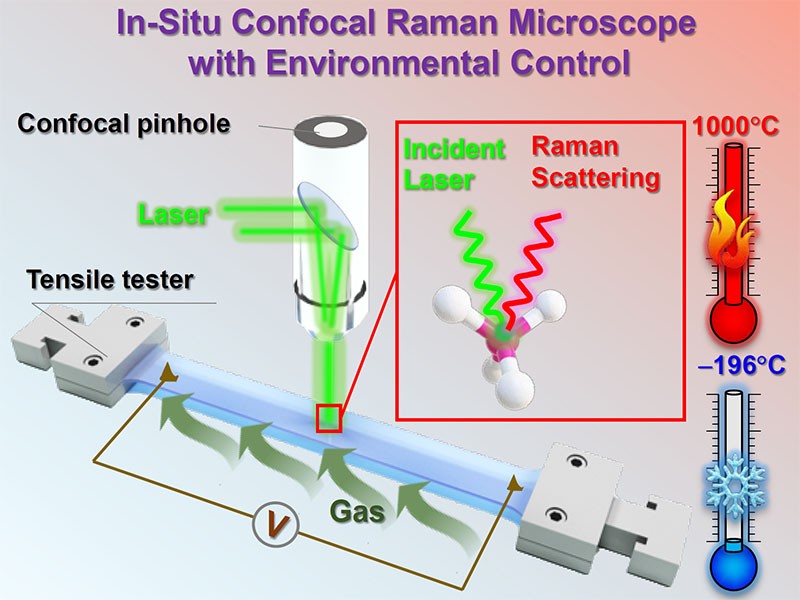Villanova Secures Cutting-Edge Confocal Raman Microscope Facility with Collaborative $523,333 NSF Major Research Instrumentation Grant

The design of advanced materials and systems across industries such as healthcare, electronics and energy production requires a better understanding of the biological and chemical processes involved, which necessitates testing environments that closely mimic real process conditions. Without the proper technology, replicating these environments is an enormous challenge, but with a new confocal Raman microscope with temperature-control stages (CRM-TCS), faculty from Villanova University, Bryn Mawr College and Cabrini University will soon possess the facility needed to enable their cutting-edge research and education projects. A $523,333 National Science Foundation Major Research Instrumentation grant provided financial support for the CRM-TCS, which will be the first of its kind in the Philadelphia area.
Villanova Mechanical Engineering Associate Professor Dr. Gang Feng serves as principal investigator on the grant. An expert in nano-bio-mechanical characterization, he explains: “The confocal Raman microscope with sophisticated environmental control will enable in vivo chemical mapping under a wide temperature range and different gas/liquid environments, providing high resolution and real-time structural and chemical fingerprints of materials and chemicals.” Put more simply, the CRM-TCS goes beyond high resolution imaging to detect molecules, thereby identifying actual materials. Most importantly, it maintains the material’s native environment so that behavioral changes can be properly studied.
Co-PI Dr. Bo Li, an assistant professor in Villanova’s Mechanical Engineering department, says, “By addressing all these needs, the instrument will greatly advance knowledge and promote interdisciplinary research in nanomaterials, thermal and chemical engineering, and bioengineering/biology.”
In benefitting researchers across these four areas, at the onset, the CRM-TCS will support seven projects at the three institutions:
- Characterization of nanostructured thermal energy storage materials for high-performance energy storage systems —PI, Dr. Gang Feng, associate professor, Mechanical Engineering
- Imaging of two-dimensional materials to promote new synthetic methods and understanding of their structure-property relations under extreme conditions, with a goal of improving sensors in energy storage and electronics—Co-PI, Dr. Bo Li, assistant professor, Mechanical Engineering
- Characterization of spin-phonon coupling in multiferroic thin films at different temperatures —Co-PI, Dr. Xuemei Cheng, associate professor and chair, Physics, Bryn Mawr College
- Characterization of solid oxide fuel cells to provide important insight into fuel reaction mechanisms and thereby improve vehicle efficiency—Co-PI, Dr. Bryan Eigenbrodt, associate professor, Chemistry
- Characterization of biomolecular age-related changes in the heart of aging drosophila (fruit fly) —Co-PI, Dr. Anna Blice-Baum, assistant professor, Biology, Cabrini University
- Characterization of molecular mechanisms of cryo-injury for developing cell preservation technologies—Senior Personnel, Dr. Jens Karlsson, professor, Mechanical Engineering
Dr. Cheng says: “Applying the CRM-TCS to characterize nanomaterials could lead to promising applications in Spintronics, information technology, magnetic sensing and biomedical engineering. I am also excited about the research opportunities enabled by this grant for young women in my group.”
“In my work,” offers Dr. Eigenbrodt, “exploring chemical systems under application-based conditions and understanding how they behave under these conditions can lead to more efficient designs.” He adds: “In my lab I try to create an atmosphere that encourages a "from creation to application" experience for our students. This new Raman microscope will make that a reality.”
For her part, Dr. Blice-Baum looks forward to “investigating chemical changes in the heart with age using the fruit fly model. The confocal Raman microscope is uniquely equipped to tell us about these changes in a novel and exciting way. We can then correlate chemical changes with physiological changes, which may hold answers to key questions about cardiac aging in humans.”
Dr. Karlsson is eager to employ the CRM-TCS to “look inside cryopreserved cells to detect their chemical signatures and determine what goes wrong during the freezing and thawing processes.”
Ultimately, Drs. Feng and Li see the CRM-TCS as a core facility in what they hope will become a new Research and Educational Center for Imaging Under Controlled Environment (REC-ICE). In addition to the projects described above, the anticipated impacts include nine upper level courses, annual workshops, K-12 outreach activities, and opportunities for dozens of undergraduate, graduate and PhD students.
